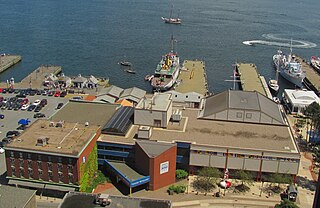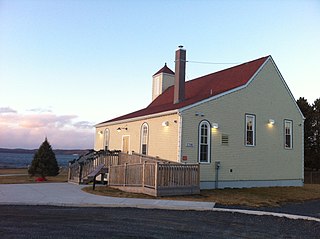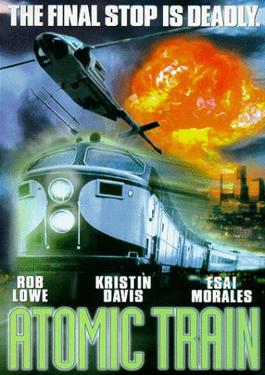
On the morning of 6 December 1917 the French cargo ship SS Mont-Blanc collided with the Norwegian vessel SS Imo in the harbour of Halifax, Nova Scotia, Canada. The Mont-Blanc, laden with high explosives, caught fire and exploded, devastating the Richmond district of Halifax. At least 1,782 people were killed, largely in Halifax and Dartmouth, by the blast, debris, fires, or collapsed buildings, and an estimated 9,000 others were injured. The blast was the largest human-made explosion at the time. It released the equivalent energy of roughly 2.9 kilotons of TNT (12 TJ).

John Hugh MacLennan was a Canadian writer and professor of English at McGill University. He won five Governor General's Awards and a Royal Bank Award.

The Maritime Museum of the Atlantic is a maritime museum located in downtown Halifax, Nova Scotia, Canada.

Barometer Rising is a romantic-realist novel by Canadian author Hugh MacLennan. The work explores life in Halifax, Nova Scotia during World War I, and its interruption by the Halifax explosion. The narrative predominantly follows and pivots upon the romantic life of Penny Wain.

Springhill mining disaster may refer to any of three deadly Canadian mining disasters that occurred in 1891, 1956, and 1958 in different mines within the Springhill coalfield, near the town of Springhill in Cumberland County, Nova Scotia. In the 1891 accident, 125 died; in 1956, 39 were killed; and in 1958, there were 75 miners killed.

Africville was a small community of predominantly African Nova Scotians located in Halifax, Nova Scotia, Canada. It developed on the southern shore of Bedford Basin and existed from the early 1800s to the 1960s. From 1970 to the present, a protest has occupied space on the grounds. The government has recognized it as a commemorative site and established a museum here. The community has become an important symbol of Black Canadian identity, as an example of the "urban renewal" trend of the 1960s that razed similarly racialized neighbourhoods across Canada, and the struggle against racism.

Atomic Train is a 1999 American made-for-television disaster-action-thriller miniseries about an accidental nuclear explosion destroying the city of Denver, Colorado. It was originally broadcast on NBC in two parts on May 16 and 17, 1999.
The Chernobyl disaster is the world's worst nuclear accident to date.

The Halifax Court House is a historic building in downtown Halifax, Nova Scotia. Its main section was completed in 1863, with the east wing, built in 1930, being the newest portion. The Italian renaissance style building was designed by William Thomas, a Toronto architect who created prominent structures across Canada, and built by George Lang.
Shattered City: The Halifax Explosion is a two-part miniseries produced in 2003 by CBC Television. It presents a fictionalized version of the Halifax Explosion, a 1917 catastrophe that destroyed much of the Canadian city of Halifax. It was directed by Bruce Pittman and written by Keith Ross Leckie. The Film Stars Vincent Walsh, Tamara Hope, Clare Stone, Zachary Bennett, Shauna MacDonald and Ted Dykstra.
Burden of Desire (1992) is a large mass-market book based on the Halifax Explosion of 1917 written by Canadian-born journalist Robert MacNeil. MacNeil, who hosted the MacNeil/Lehrer NewsHour, has also published other fiction and non-fiction books including Breaking News (1999) and Wordstruck: A Memoir (1989).

Shattered City: The Halifax Explosion and the Road to Recovery is a 1989 Canadian non-fiction book by Janet Kitz describing the experience of the Halifax Explosion with an emphasis on the experience of ordinary people and families who became victims or survivors of the 1917 munitions explosion in Halifax, Nova Scotia. The book broke new ground, making extensive use of oral history interviews conducted by Janet Kitz to tell previously unknown stories from the event, illustrated by documents and photographs collected by the author as well as images and artifacts from the Maritime Museum of the Atlantic. The first book published in many years about the explosion, it broke the record for the largest number of books ever sold at a book launch in Nova Scotia and has been credited as creating a renaissance in published accounts about the 1917 disaster. The book has been reprinted several times and has remained a definitive account of the disaster which has influenced numerous works that have followed. Janet Kitz went on to write two follow-up books: Survivors: Children of the Halifax Explosion (2000) which explored in more detail the stories of children who survived and December 1917: Revisiting the Halifax Explosion (2006) with Joan Payzant which looked at the impact of the explosion on the landscape of Halifax and Dartmouth.

SSMont-Blanc was a cargo steamship that was built in Middlesbrough, England in 1899 for a French shipping company. On Thursday morning, December 6, 1917, she entered Halifax Harbour in Nova Scotia, Canada laden with a full cargo of highly volatile explosives. As she made her way through the Narrows towards Bedford Basin, she was involved in a collision with Imo, a Norwegian ship. A fire aboard the ship ignited her cargo of wet and dry 2,300 tons of picric acid, 500 tons of TNT, and 10 tons of guncotton. The resultant Halifax Explosion killed approximately 2,000 people and injured about 9,000.

Nimbus Publishing is a publishing company based in Halifax, Nova Scotia. The company specializes in subjects relevant to the Atlantic Provinces.
John "Eric" Davidson was one of the last survivors of the Halifax Explosion. He was two years old when he was blinded by the Halifax Explosion on December 6, 1917. At the time of his death in 2009, Davidson was the penultimate living survivor with permanent injuries from the Halifax Explosion, which killed more than 1,600 people.

SS Imo was a merchant steamship that was built in 1889 to carry livestock and passengers, and converted in 1912 into a whaling factory ship. She was built as Runic, renamed Tampican in 1895, Imo in 1912 and Guvernøren in 1920.
Ashpan Annie was the name given to Anne M. Welsh, a "Halifax Explosion" survivor.
Stella Maris was a steamship built in 1882 as the Royal Navy gunboat HMS Starling and converted to steam tug in 1905. Stella Maris played a major role in the events of the Halifax Explosion in 1917.

Joan Payzant was a Canadian author most known for her historical fiction. She wrote about the history of Dartmouth and Halifax, Nova Scotia, Canada.

Janet F. Kitz was an educator, author and historian in Halifax, Nova Scotia who played a key role in the recognition of the 1917 Halifax Explosion, the largest man-made explosion prior to the atomic bomb and the worst man-made disaster in Canadian history.













